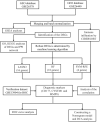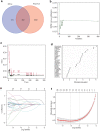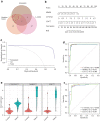Analysis and validation of diagnostic biomarkers and immune cell infiltration characteristics in pediatric sepsis by integrating bioinformatics and machine learning
- PMID: 37115484
- PMCID: PMC10533616
- DOI: 10.1007/s12519-023-00717-7
Analysis and validation of diagnostic biomarkers and immune cell infiltration characteristics in pediatric sepsis by integrating bioinformatics and machine learning
Abstract
Background: Pediatric sepsis is a complicated condition characterized by life-threatening organ failure resulting from a dysregulated host response to infection in children. It is associated with high rates of morbidity and mortality, and rapid detection and administration of antimicrobials have been emphasized. The objective of this study was to evaluate the diagnostic biomarkers of pediatric sepsis and the function of immune cell infiltration in the development of this illness.
Methods: Three gene expression datasets were available from the Gene Expression Omnibus collection. First, the differentially expressed genes (DEGs) were found with the use of the R program, and then gene set enrichment analysis was carried out. Subsequently, the DEGs were combined with the major module genes chosen using the weighted gene co-expression network. The hub genes were identified by the use of three machine-learning algorithms: random forest, support vector machine-recursive feature elimination, and least absolute shrinkage and selection operator. The receiver operating characteristic curve and nomogram model were used to verify the discrimination and efficacy of the hub genes. In addition, the inflammatory and immune status of pediatric sepsis was assessed using cell-type identification by estimating relative subsets of RNA transcripts (CIBERSORT). The relationship between the diagnostic markers and infiltrating immune cells was further studied.
Results: Overall, after overlapping key module genes and DEGs, we detected 402 overlapping genes. As pediatric sepsis diagnostic indicators, CYSTM1 (AUC = 0.988), MMP8 (AUC = 0.973), and CD177 (AUC = 0.986) were investigated and demonstrated statistically significant differences (P < 0.05) and diagnostic efficacy in the validation set. As indicated by the immune cell infiltration analysis, multiple immune cells may be involved in the development of pediatric sepsis. Additionally, all diagnostic characteristics may correlate with immune cells to varying degrees.
Conclusions: The candidate hub genes (CD177, CYSTM1, and MMP8) were identified, and the nomogram was constructed for pediatric sepsis diagnosis. Our study could provide potential peripheral blood diagnostic candidate genes for pediatric sepsis patients.
Keywords: Bioinformatics; Biomarkers; Immune cell infiltration; Machine-Learning; Paediatric sepsis.
© 2023. The Author(s).
Conflict of interest statement
The authors have no conflict of interest to declare.
Figures



References
-
- Cecconi M, Evans L, Levy M, Rhodes A. Sepsis and septic shock. Lancet. 2018;392:75–87. - PubMed
-
- Fleischmann-Struzek C, Goldfarb DM, Schlattmann P, Schlapbach LJ, Reinhart K, Kissoon N. The global burden of paediatric and neonatal sepsis: a systematic review. Lancet Respir Med. 2018;6:223–230. - PubMed
MeSH terms
Substances
Grants and funding
LinkOut - more resources
Full Text Sources
Medical
Research Materials

